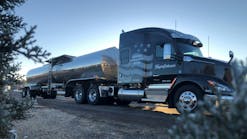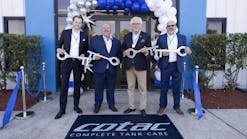A-One’s Lubrano shares tips on scrubbing away the most stubborn substances like latex, resin and heavy crude
EVERY tank wash is a little bit different, with unique cleaning challenges and constraints to conquer daily.
David Lubrano’s considered them all.
After six years with A-One Chemicals & Equipment, Lubrano, the vice president of sales, shared his hard-won insight on some of the most difficult challenges tank washes encounter, including scrubbing away stubborn substances like latex, oil and resin, during the Tank Cleaning Council segment of the National Tank Truck Carriers Safety & Security Council meeting in Reno, Nevada.
“Everyone’s cleaning different types of products, but hopefully some of the recommendations I make will shed light on some ways we all can improve cleaning efficiency in some way,” Lubrano said.
Latex cleaning
The process for cleaning latex out of tanks starts with the basics: relieve pressure, drain the heel — to keep as much chemical out of the waste water as possible — flush with water and ventilate.
The flush is useful with latex since it’s water soluble.
“We recommend cold water vs. hot water because, when you’re dealing with a lot of different trailers, you’re going to have — even after you flush it — easy chunks that are hanging around all over the place,” Lubrano said.
The next step is to inspect for loose “skins” and pressure wash.
The goal is to get inside the tank and remove as much of the “easy” stuff as possible to keep it out of the wash vat.
“Whatever’s left in there that is easy stuff, when you start running chemicals, or circulating chemicals inside … you’re wasting chemicals, theoretically, because it’s going to sit there and react with that latex,” Lubrano said.
For the gunk that’s harder to remove, a “presolve” comes in handy.
A presolve is a blend of solvents that strip away, or break down, heavy buildup left inside tanks. A-One’s line of solvent strippers work much like a paint thinner, but more effectively, because they were designed for specific tasks, and without the flammability and toxicity of paint thinner.
A-One’s presolves, including Dyna’Strip 4000, have flash points higher than 145° F.
“The idea is to have a solvent that prevents labor-intensive work,” Lubrano said. “In the latex world, it’s scraping. You’ve got to jump in and start scraping these trailers out, and it’s hours and hours of work.”
Finishing the job
The company also sells a mechanical latex paint remover called the Eliminator that it says soaks an 8,000-gallon tank with 13 gallons of product. The Eliminator kit includes a drum and dolly, a jumper hose to connect to the vat and a return line back to the drum to keep the solutions circulating.
“You can usually knock out five trailers or so using 13 gallons,” Lubrano said. “So you can look at the cost and analyze it. ‘If I’m spending such-and-such many hours sitting in there scrapping, would it make sense, and can I streamline my cleaning process, by utilizing some chemistry that will melt this stuff down?’
“And then, after that, hit it on your vat spinner and blast it away.”
A temperature-controlled hot vat wash set between 180-190° F is crucial for effectiveness, Lubrano said. If the wash is too cool, foam can build up and spill out, wasting product and money. If it’s too hot, tank wash systems can start to experience cavitation problems with pumps.
Lubrano also recommends using a dedicate latex stripper vat over a caustic vat.
“I’ve found that nothing works as well, particularly on latex, as a stripper vat,” he said. “The tough part is not enough tank washes clean enough latex to justify having its own dedicated vat. So you’re almost always going to see caustic vats. Not always, but you’ll see a lot of caustic vats because it’s such a universal cleaner.
“But there are boosters you can use to boost the caustic vat if you want something more versatile.”
Rinse and dry to finish the process.
Resin cleaning
The basic steps for cleaning resin, and most other products, is the same as for latex.
Resin isn’t water soluble, so flushing with water isn’t effective, but presolves still are a powerful solution, especially with more flammable resins with higher melting points of 400+ degrees F.
Recommended vat chemicals include caustic soda, typically with 10% to 12% titration.
“Keep in mind titration is not the same as just percent caustic,” Lubrano said.
“You actually need to have a titration kit and check that. Otherwise it’s not going to perform the way you want.”
There is, however, once downside Lubrano sees with caustic vats.
“If you’ve got real hard water you may have white residue left behind,” he said. “An easy way to help prevent that white staining is by adding a little bit of a detergent to it. That helps a lot with getting a clean finish.”
Crude cleaning
With cleaning heavy crude and lube oils, start with pressure relief and heel draining, then blast the tank with steam.
“When you get a lot of sludge buildup in there, which is the reason you steam, you want to get up to about 225 degrees, and the idea is … it’s going to lower that viscosity and allow you to drain that heel,” Lubrano said.
At tank washes he’s visited, Lubrano said it’s not unusual to dump diesel into a tank and steam from the bottom. While the method often is effective, and diesel is an affordable commodity with versatile cleaning power, it leads to dumping more diesel into the waste — and more expensive disposal.
That’s why he favors a hot diesel wash over steaming with diesel.
“With a diesel vat, if you’ve got a steam coil inside, obviously you’re not introducing that water in it,” Lubrano said. “You can recirculate it, and then once the diesel is spent you can take that out and dispose of it as necessary.”
In some cases, like with high-paraffin crude oils, diesel isn’t a great option.
Presolves are a good way to go in that case, although some citrus solvents also work, albeit at a higher price point.
Vats, pumps
Basic specs for a heated chemical vat system include:
• Insulated stainless steel vat
• 500- to 1,000-gallon capacity
• Stainless steel steam coil with temperature control valve
• Manual or air-actuated valves
• Spinner pump with strainer basket: 40HP multi-stage centrifugal pump (stack pump) for lower operating cost, smaller footprint; 75HP centrifugal pump for handling larger solids
• Spinner output: Gamajet 4 or Tankjet 360 with 3/8” nozzle, 130 gallons per minute (65 gpm per nozzle at 275 psi)
• Return pump with strainer basket: 7.5HP centrifugal









